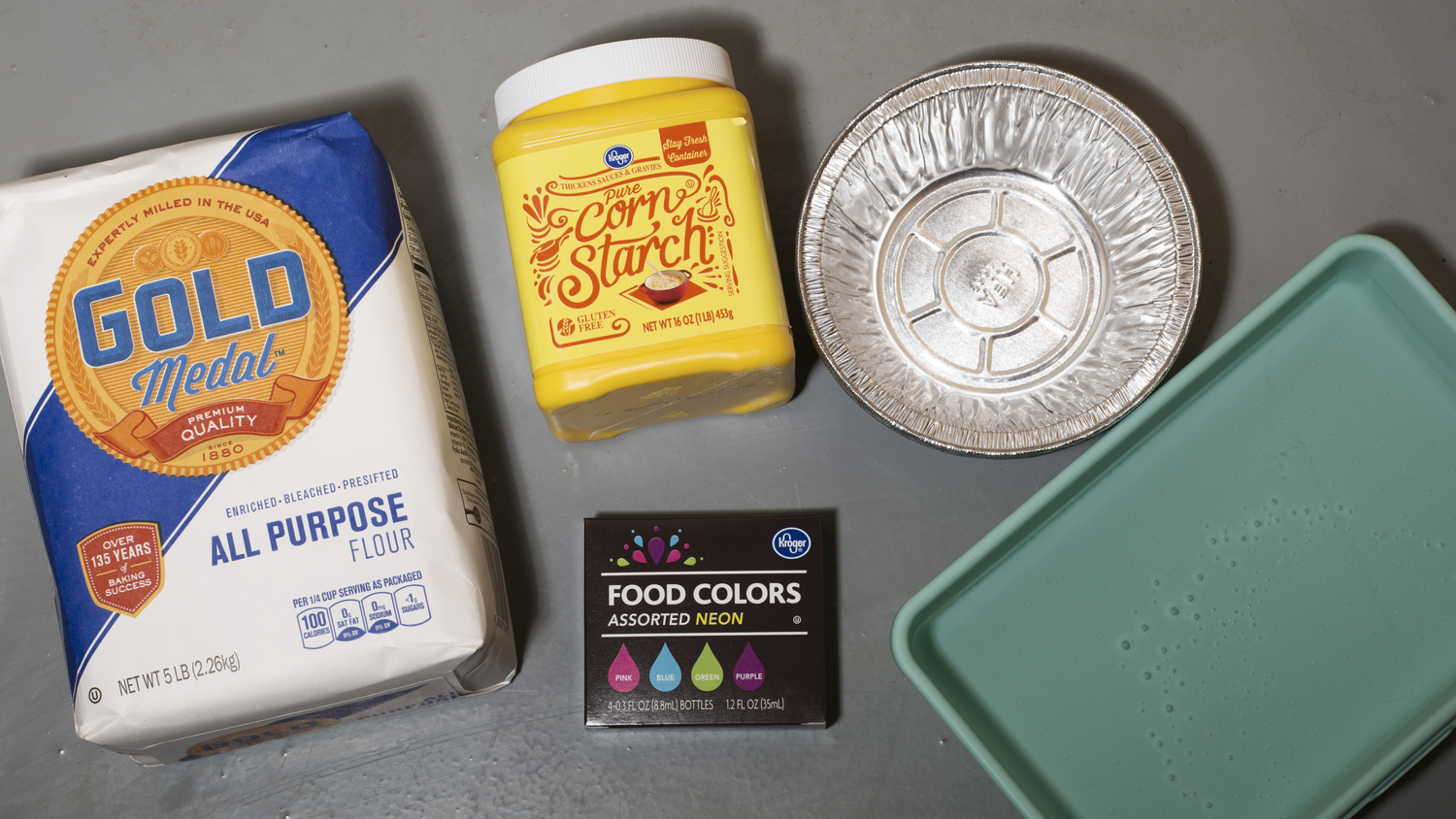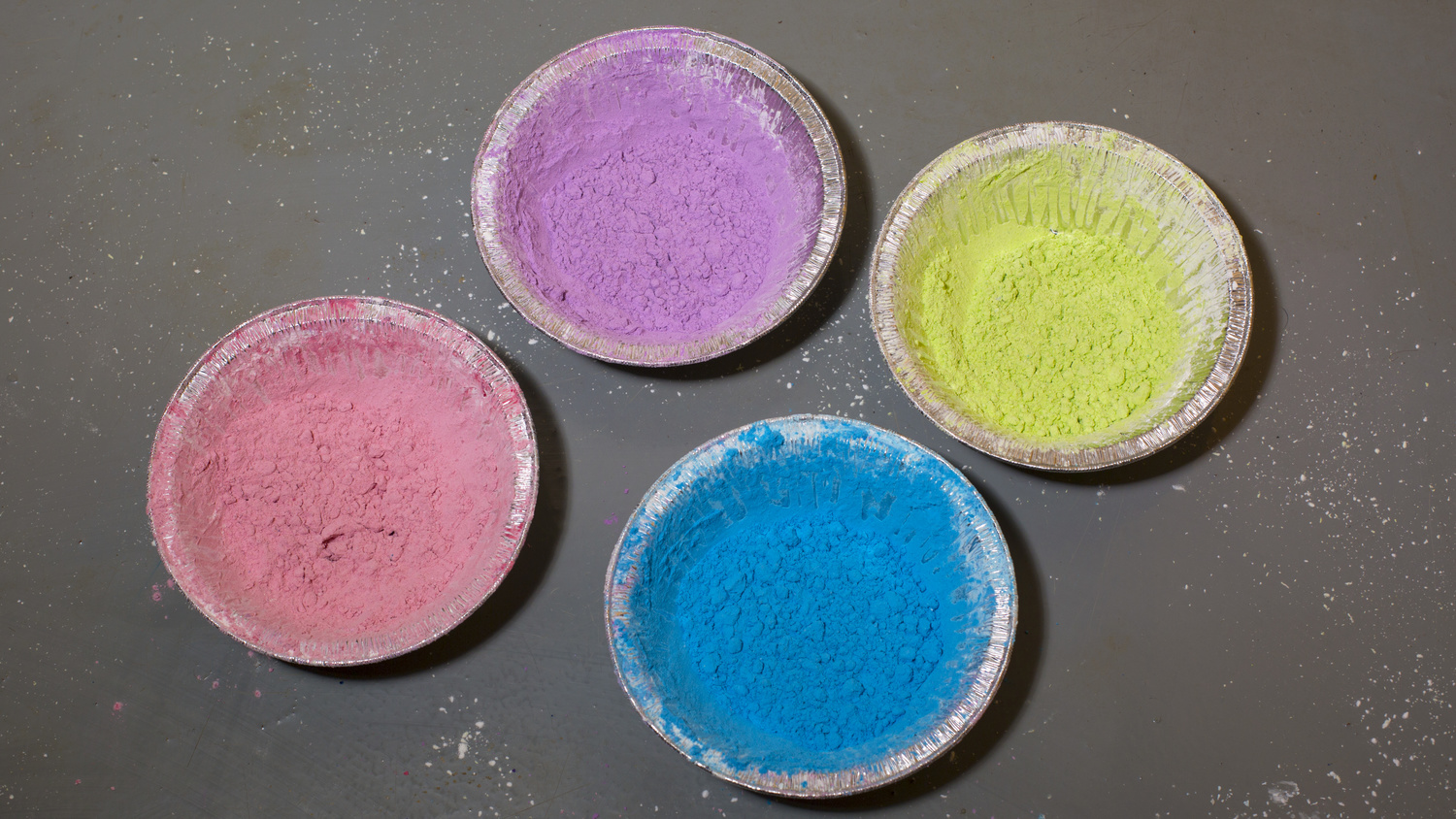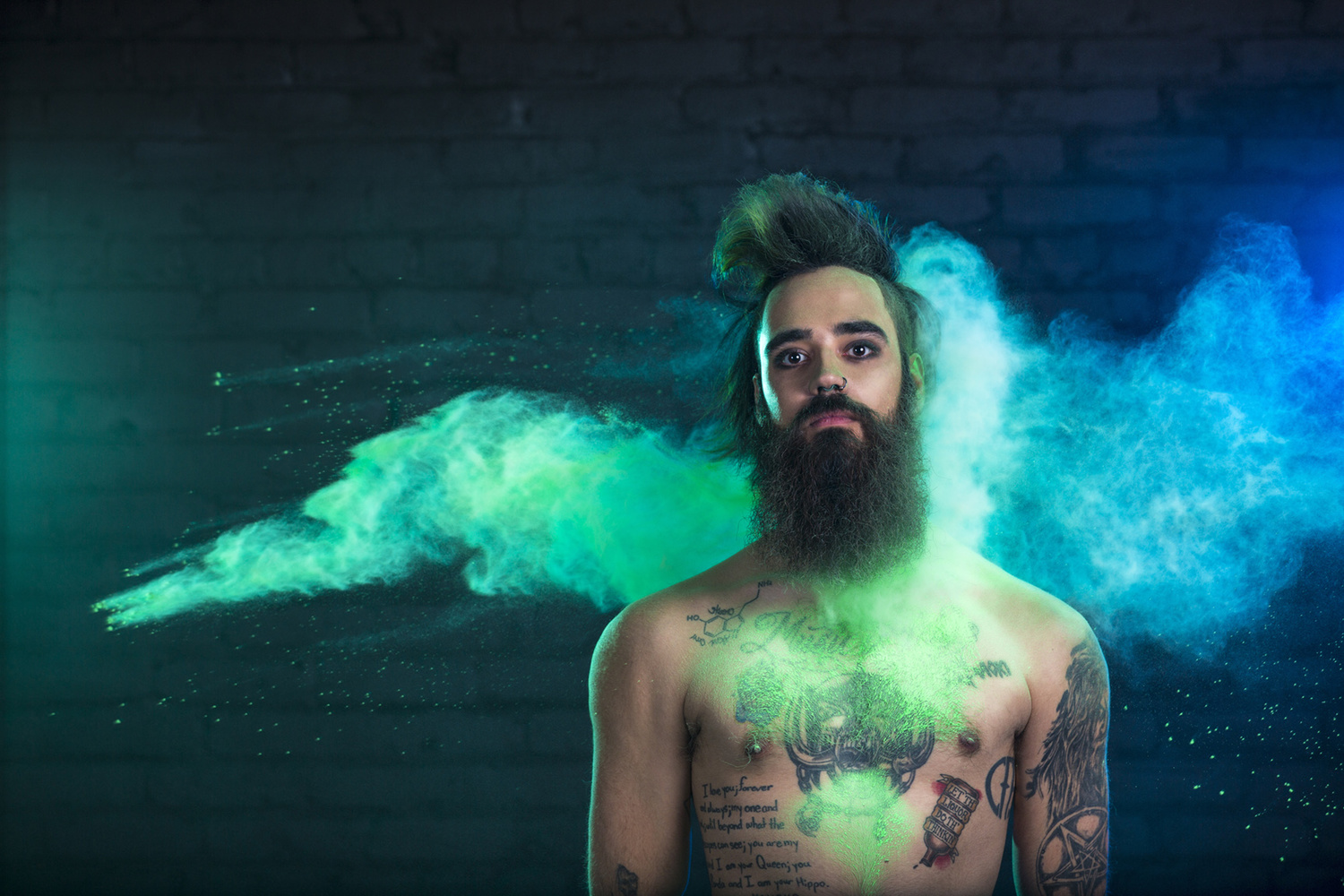If you've ever wondered where photographers are getting this gorgeous colored powder for portraits, stock imagery, and dance photos, it turns out it's very easy and affordable to make at home. This powder can be used in endlessly creative ways to add an eye-catching unique and fine art element to your studio or outdoor photography. Clients and followers love seeing these fun images, and it's an absolute blast to photograph.
What You'll Need
You can actually find everything you need to create these powders in your grocery stores baking aisle:
- Cornstarch or flour
- Food coloring
- Mixing trays or bowls
- Gloves
- Water
I purchased both cornstarch and flour to test the consistencies; I ended up liking the cornstarch better because it was more powdery rather than the smoky look the flour mixture created. You can mix both or use one or the other, but I would start with just one to find out what you prefer.

Supplies for making your own colored powder for photoshoots.
The Simple Process
The cool thing about this project is the process is pretty flexible; you can change the consistency and the vibrancy of the colors based on how much of each ingredient you mix with the others.
- Set up a workspace; you can lay down plastic or work outside or in your garage like I did. Just make sure you're not around anything you don't want food coloring on!
- Start with either cornstarch or flour in your mixing container. I would start with about a cup and work your way up by adding more if you're wanting a larger quantity of color powder.
- Start adding drops of food coloring. I started with 5-10.
- With gloves on, start rolling the flour or cornstarch between your fingers to break up the now clumped mixture. You will start to see the color changing as you work with the powder.
- Keep adding food coloring until you have the desired color intensity. Less coloring will leave you with pastel colors and more will create a very vivid color.
- Let the mixture dry; it only took about 30 minutes for mine. If you add water to yours, you will definitely need to allow a few hours for drying before photographing it.
Optional: You can add water to end up with a larger quantity of color powder. When you add water, it makes it tougher to mix and you have to let it dry for a few hours or even overnight, so I ended up using only food coloring and cornstarch for mine.

My results.

Photo by Rivata Dutta, Los Angeles.
A Few Tips for Using the Colors
- Make sure to have an assistant on set; it is not easy to get the shots you want while dispersing the powder yourself or having the model do it.
- You can simply have your helper throw the powders where you want to see them in the shot, or you can get creative in how they're thrown by using things like empty condiment bottles, party poppers, fans, plastic bags, etc.
- Make sure you're shooting with a fast continuous shutter speed and a decent amount of light so you can catch the powder as it flies in the air.
- Try your hardest not to get it in your subject's eyes; it is non-toxic but will make their eyes red, and it hurts.
- Be sure to protect your gear from the powder.

Behind-the-scenes photo from Steve Cook.

Photo by Steve Cook, Las Vegas.

Photo by Nik Thavisone.

Photo by Ashraf Hussain.
If you try it out, be sure to share your images in the comments! And keep a vacuum nearby for when the shoot is over.
Images used with permission. Lead image by Nik Thavisone. Article images by Rivata Dutta, Steve Cook, and Ashraf Hussain.
Warning: There is a flammability hazard with airborne flour and corn starch. Exercise extreme caution and take preventative measures if you use them during a shoot.







Please be aware that this material is EXTREMELY combustible when airborne. It is the same scenario that causes grain elevators to explode catastrophically when contained grain dust is exposed to an ignition source -- even a spark.
If you use this material, you'll need to be sure there is NOTHING on the set that will ignite it. Frankly, it shouldn't be used (or inhaled), but if it must be used, it should be done only outdoors and with control so the model or others on set don't inhale the material.
Cornstarch is used for baking.... In the oven.... how is it combustible??? can you link me to something!
https://www.youtube.com/watch?v=gLFUlDv8n8M
wow really interesting, thanks for sharing, I feel like it would take a lot to make this happen accidentally during a photo shoot, but still good to know to be safe!!
This was done over a candle. If you have enough of this stuff flying through the air and a customer lights a cigarette, or clicks a lighter, or a pilot light goes on, it could cause extreme harm to people.
Absolutely, we added a warning to not do this around any sort of flame. Thanks so much for the input.
https://www.youtube.com/watch?v=BXWShRzbesU
https://hughesenv.com/dust-explosion-taiwan-concert-caused-corn-starch/
Thank you
Thanks for the info! We added a disclaimer.
Thanks Alex!
The results look striking. How long did the cleanup take? I remember having a flour bomb night at a youth group I attended once. I think the church hall we used still has flour-infused wall crevices, decades later!
After I made mine the cleanup was only about 5 min because I made small quantities, but using a broom is the best way to go because if you get it wet it just smears color all over your floor lol
You've done well to make small quantities go such a long way, to make the clean up so easy. Flour bomb fights used bags of the stuff when I was a teenager, hence the big (and not fully successful) cleanup job required back then...
Long time lurker and just registered co comment on this. Last year I had a chance o work with this powder for a commercial shoot and after some testing I can say
1- Get the fastest flash duration you can... in my case, profoto pro 10 and set them at the same power level so you get stable freeze throughout the image.
2- Once you start shooting things get messy QUICK, so plan accordingly.
3- You need more powder than you think at first
4- As with everything with color, do cool ones and if you mix, think complementary
5- Forget shooting bursts and concentrate on getting the right moment
6- Plastic covers are your friends ( dust obstructing pack or head fans )
7- The powder we used was brought by a special FX crew, so don't know if was the same as here but washed perfectly leaving no stains or marks
Have fun!
WOW Great shot!!!! Thanks so much for leaving this comment, very helpful indeed and you should comment more often!!
Have you ever photographed the powder by itself on a black background?
Nope, all we did was white :)
Let me know if you try it!!
Wow. Gorgeous shots! All I can think about is the mess :-)
Wasn't too bad when I used it, as long as you keep it dry and use mostly a broom it gets up pretty quickly!
This post is VERY DANGEROUS and should be taken down immediately. Flour is extremely combustible and should never be used for these kind of photos!!! If a flashtube would break during the shoot this will definitely lead to extreme injuries to both the model as the photographer. There are already several cases where people were seriously injured and even killed.
Hey Koen, thanks for your concern but small amounts of flour and or cornstarch are not a risk. Please read this: https://www.wired.com/2008/03/the-explosive-t/
Hi Gabrielle, I am a engineer working in the bulk, grain, flour and pharmaceutical industry for over 30 years. I have personally witnessed the result many dust explosions over the years and can assure you that the amount of material present does not prevent a dust explosion. I have seen a lab blow up with a dust explosion that started with 100 grams of material. It resulted in 3rd degree burns for 3 victims present in the lab. Not the amount of material but the ratio between the amount of dust and the air results in a combustible mix. Problem with dust explosions is that they propagate extremely. This is because the first explosion generates a shockwave that results in the settled dust on the floor to get airborne and thus making an new combustible mixture with the air which ignites a second, third, fourth,… time. Sometimes a dust explosion keeps on going for minutes after the initial spark. Of course the less material present the lower the explosion power generated will be, but a kilogram of material can easily burn down a complete studio and everyone in it. I am not going to comment any further and think I have done everything to warn you. The responsible thing to do would be to take down this post.
+1 to the above. Flour is nasty stuff, as the residents of London circa 1666 can attest.
The article (with disclaimer) is basically equivalent to putting a disclaimer on a "go shoot on the railway tracks" post
There haven't been any accounts of injuries during photoshoots that I found. It's not enough to make an explosion happen.
Also, raw flour can contain bacteria that can make people sick. Aside from the extreme danger of setting your whole set on fire with it, you could get a client sick if they were to eat it.
Yes absolutely, no eating the flour lol! Bacteria is on everything now days though :/
Never knew it was flammable! Used this so often during college. Some of us even had a cigarette in and around the studio while assisting the other students with their flour bomb projects. Never had any idea we stood a chance of becoming a human fireball.
It's only combustible in large amounts, I had to do some research on this. Unless your lighting it with a blowtorch etc it's not going to be dangerous during a photoshoot
I think people are a little out of hand with the warnings on stuff, it'd be VERY difficult and quite unlikely for a problem to arise doing photos like this.
I guess you guys didn't read Koen De Clerck's comment above . . . 100grams -- a tiny amount -- sent 3 people to the hospital with 3rd degree burns.
It is very unlikely to make this happen during a photo shoot, just no flames! And to be safe use speed lights or another lighting where the bulb is covered. And for precaution don't throw any right at the light
You can continue to come up with excuse after excuse, reason after reason, for continuing to put yourself and your clients/subjects at risk. That means you just don't care about other people's safety, much less your own. Someday, this will bite you.
I do care about everyone's safety. There are zero stories of this happening during PHOTOSHOOTS, therefore with the right precautions, I know nothing will happen during one of mine. There are always risks to any photo shoot, to get a shot is sometimes risky, I could get hit by a car, I could fall off a cliff..
Sorry, don't buy it. You can't be sure that your subject, who is immersed in the powder, isn't inhaling it, and symptoms of chemical pneumonia may not show up for some time, possibly months. By then, you and they are so far removed from each other that you may not know what happened to them, and since you didn't warn them of the dangers, they might not think you're to blame.
That may be the reason there are no stories about anything happening on photoshoot -- the victim is not putting two and two together.
That no one has been blown to bits in an explosion is just dumb blind luck.
Yeah, this is a well known hazard. The powder or dust basically becomes the means of a small chain reaction as each tiny grain is highly flammable especially with flour. "Flour and many other carbohydrates become explosive when they are hanging in the air as dust. It only takes 1 or 2 grams of dust per cubic foot of air (50 or so grams per cubic meter) for the mixture to be ignitable. Flour grains are so tiny that they burn instantly. When one grain burns, it lights other grains near it, and the flame front can flash through a dust cloud with explosive force. Just about any carbohydrate dust, including sugar, pudding mix, fine sawdust, etc., will explode once ignited."
I've yet to find any reports of injury during photoshoots though. Only in factories and places like that
https://www.wired.com/2008/03/the-explosive-t/
Very cool! The shots turned out awesome.
Aren't they awesome!!
Going to have to try this out soon, thanks!
Can't wait to see your results ;)
Koen De Clerck and David Drugg's comments about this kind of material being extremely explosive is right on and very important -- it's the reason smoking or anything that could produce a spark is prohibited from areas in and around grain silos -- there is always lots and lots of dust in the air around those things, and they can -- and have -- exploded, destroying huge concrete silos.
But he mentions something else that I think is much, much more important -- preventing anyone from inhaling the dust, which, with all the dust floating around in the air, is virtually impossible. The reason I think this is so much more important is because when particulate matter (i.e., dust or powder) is inhaled into the lungs, it can easily cause something called Chemical Pneumonia. From WebMD:
“In chemical pneumonia, inflammation of lung tissue is from poisons or toxins. Many substances can cause chemical pneumonia, including liquids, gases, and small particles, such as dust or fumes, also called particulate matter. Some chemicals only harm the lungs; however, some toxic materials affect other organs in addition to the lungs and can result in serious organ damage or death.”
You can read more about it here: http://www.webmd.com/lung/chemical-pneumonia
Frankly, I would never offer a client a powder shoot for this reason. I don't want chemical pneumonia, and I don't want my clients to get it. Be aware, the signs may not show up for quite some time after exposure. But it can cause huge problems. It's the reason construction companies require their employees wear masks or respirators around heavy dust.
By the way, another consideration in all of this is the liability -- if something goes wrong and there is a fire or a client or employee is hurt, or if someone does come down with chemical pneumonia, as the photographer, you could be sued and sued and sued some more.
You are right, that's why it is important we have insurance, an injury could happen anytime, whether the flour is present or just standing outside under some trees. Life
Seems like an informative article has been picked apart needlessly. Imagine a story piece about color dust photos on train tracks with selective coloring 🤣😂🤣😂
OMG that’d be funny to witness.
I’m working my way thru a self-portrait project and will definitely give this a try. Thanks for the inspiration!
Haha I know right, I was just thinking how flammable hairspray is.. and chances are when photographing a woman, and even men 90% of the time they've got hairspray in their hair.
Share your results with me when you try it!! I actually tried throwing my powders at my own face for the article but couldn't get nearly what these photographers were getting so I shared some fellow artists work that I found on Instagram.
I’ll have to remember to share it with you. 353 days to go, I’m sure to get around to it once or twice. :)
Great article. Thanks.
Have Fun,
Jeff
Thanks Jeff!!